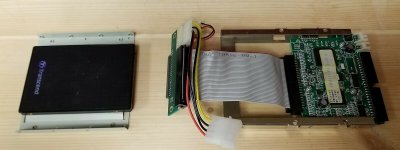I do agree with Cory: if someone made a SCSI to SATA converter, we could do away with all the nonsense and just pop standard, modern HDs inside
Just to be clear here, that is
already the case on PCI PowerMacs, and as has been noted, is also already the case on IDE-having Macs.
There's no good reason not to put a SATA card in a PTP unless you already have a UWSCSI card in there for some non-storage task and want to use it for both.
SCSI to SATA would be a huge benefit though, in the range of '040 desktops and 601/NuBus PowerPC desktops, which can't run a SIL3112 but
can in theory address up to 2TB volumes and use HFS+ for data partitions.
The other thing here is it's tough to say whether a new, hobbyist-led/designed SATA/SCSI converter would result in "nonsense" or not. At the very least, it seems like there's a handful of use cases that need to be considered. (50/68/SCA, and 2.5-inch.)
Does the PTP have a second SCSI bus in it? If so, you might try putting the SCSI2SD on that bus instead, just to see if that'll help things along.
The v6 is a more difficult beast to tame than the v5 family. Last year, a friend and I were doing some benchmarks, me on an 8600 after he helped me update the firmware, and then he got better results himself after updating the firmware.
I think I need to pull out the 8600 because now I'm wondering about whether anything can be done about some of the software stability issues the scsi2sd can bring about with faster Macs.
In reality though, your PTP and my 8600 would benefit from SATA card installations. (I have a couple on hand at the moment, destined for vtools, I might pop one in for a bit just for fun.) I happen to be using the v6 because I had one laying around and wanted to test it, but it's far from the best possible choice for that group of machines. I'll probably move it to a NuBus machine like my 6100 or Power120, where SATA doesn't exist as an option unless I splash a few hundo down on an existing acard scsi/sata adapter.
as well as SCSI2SD there's artmixs SCSI-CF and SCSI-SD adapters. I've never had an issue with them.
The CF adapters are good. I need to go look again, the SD adapter was a SCSI2SD 4 or 5 clone last time I looked, if they've got something different then that's worth looking at.
The CF adapters were faster than the SCSI2SD, but you pay
dearly for the speed and operational simplicity.
The SCSI2SD is arguably one of the more successful mac-led vintage hardware projects and that you can buy the v5.1 for $60 a pop is really impressive for this
kind of thing.
The other thing here is that looking at
Artmix's site right now, it appears they've shifted gears entirely into manufacturing SCSI2SD clones under different names, I don't see any CF hardware on their site.
If that's the direction even artmix has gone, then I think the issue here is documentation and troubleshooting and not with the scsi2sd itself, given that this vendor is using it to replace their own previous higher performance product.


